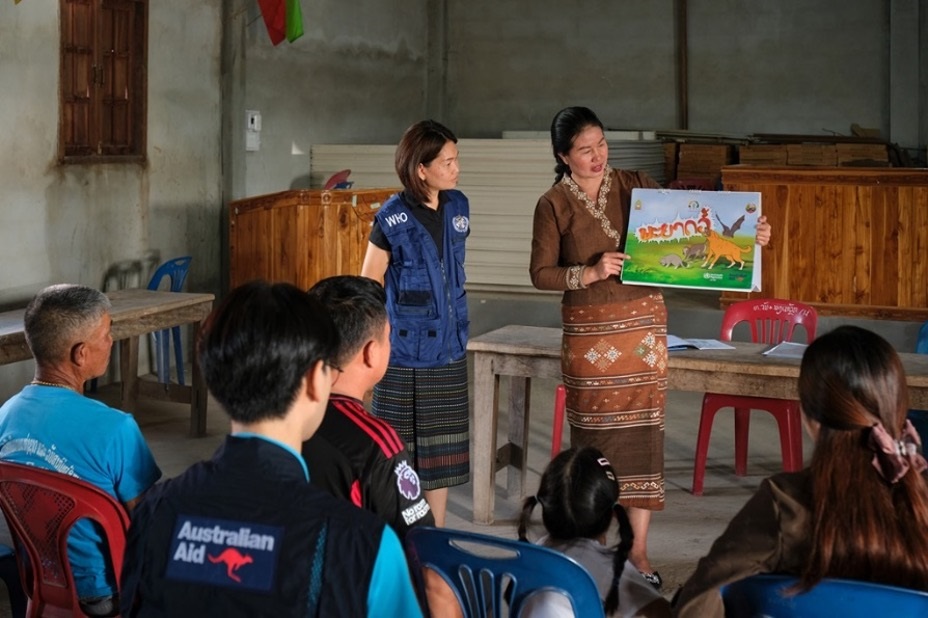/data-and-analytics-(dna)/data-exchange-(dex)/who-presence-in-countries--territories-and-areas.tmb-1920v.jpg?sfvrsn=f1146a2_2)
Data-driven rabies control for elimination by 2030 in Lao People's Democratic Republic
Stronger WHO country presence for a healthier and safer world
Joint Outcome 6.1.
Detection of and response to acute public health threats is rapid and effective
Rabies is a preventable yet fatal zoonotic disease that poses a significant public health risk in Lao People's Democratic Republic, where reliable data and access to post-exposure rabies vaccination are limited. Over the past 10 years (2014–2024), an estimated 59 rabies-related deaths have occurred in the country, according to the National Centre for Laboratory and Epidemiology’s weekly report, with a lack of awareness exacerbating the issue. To address these challenges, the World Health Organization (WHO) Lao People's Democratic Republic provided support, in collaboration with the Ministry of Health (MoH), the Government of Australia and the United States Agency for International Development, to launch a pilot project in Xayaboury Province. This initiative established a community-based rabies reporting and response system, trained over 830 individuals and resulted in the reporting of 837 animal bite cases within five months. These improvements have laid the groundwork for strengthening the country’s rabies surveillance and achieving the country’s goal of eliminating the disease by 2030.
WHO Lao People's Democratic Republic worked closely with the MoH and the Ministry of Agriculture and Forestry to address critical gaps in rabies surveillance and response. Tailored to the specific needs of Xayaboury Province, the initiative established a standardized reporting system, supported by logbooks for accurate data recording. WHO provided technical assistance through comprehensive training for 830 individuals, including health workers from 76 health facilities and authorities from 276 villages. The training programme covered critical areas such as rabies symptoms, prevention, data entry, proper reporting and referral procedures. This capacity-building effort ensured that all stakeholders were equipped with the necessary knowledge to manage rabies cases effectively.
WHO's assistance
Community engagement was a cornerstone of the initiative. Village heads and health volunteers played a pivotal role in creating a robust reporting system. Regular monitoring visits by provincial, district and health centre staff reinforced accountability and ensured consistent reporting of animal bite cases. WHO supported the distribution of over 1500 flip books and 2800 posters, raising awareness about rabies prevention among community members.

Village head educates community members in Xayaboury Province on rabies, animal bite prevention and response measures.
The impact of the pilot project has been significant. Between August and December 2024, 837 cases of animal bites were reported across 230 villages in 11 districts, including 13 cases identified at the village level and 824 cases reported by health facilities, according to the National Centre for Laboratory and Epidemiology. This early detection has contributed to timely hospital referrals and life-saving treatments, addressing what could have been fatal outcomes for many.
Key lessons
Key lessons learned include the importance of continuous evaluation and flexibility in addressing on-the-ground challenges. For instance, adapting training content to local contexts and enhancing community participation proved essential for improving reporting accuracy. WHO’s collaborative approach with the MoH and other stakeholders has laid the foundation for scaling this model to other high-risk areas.
To ensure long-term sustainability, WHO emphasized capacity-building at the community level and within the health system. These efforts have strengthened local ownership and accountability, enabling Lao People's Democratic Republic to independently implement targeted, evidence-based interventions. This initiative serves as a model for other regions, demonstrating the value of data-driven prevention and response in achieving the ultimate goal of eliminating rabies by 2030.
These initiatives led to measurable improvements, such as increased access to health care services, enhanced health literacy, expanded green spaces and strengthened community engagement. Despite the successes of the Healthy Cities initiative, several challenges emerged, underscoring the need for adaptability and strategic adjustments. Scaling up the number of Healthy Cities requires strong leadership and capacity at the local level to identify gaps and develop innovative solutions tailored to each city’s unique context. The recently established WHO Healthy City Network also calls for heightened awareness and advocacy to encourage broader participation among cities. Additionally, the complex requirements for accreditation and city planning highlighted the need for comprehensive support, including the translation of essential documents into Thai.
The pilot project in Xayaboury Province has demonstrated the effectiveness of a community-based, data-driven approach to rabies surveillance and response. By expanding this model to other high-risk areas, WHO Lao People's Democratic Republic and the MoH can strengthen zoonotic disease surveillance, improve vaccine distribution strategies and enhance rapid response mechanisms. Sustained investment in capacity-building and data utilization will be key to achieving the national goal of eliminating rabies by 2030.
